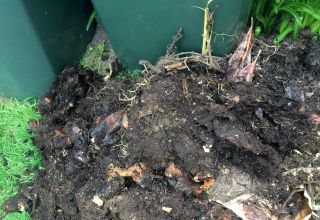
Young tender plants raised in a warm protected environment need to be properly acclimatised to outdoor conditions over the next few weeks
It’s time to plant young seedlings, raised indoors, out in the garden or allotment. But do it too abruptly and you’ll kill them.
These days, a great many gardeners are growing the plants for their garden from seeds.
This allows a gardener to have access to wide variety of plants that are not available in their local nursery or garden centre.
Growing plants from seeds is easy, as long as you take a few precautions. One of those precautions is to make sure that you harden off your plants before setting them out in your allotment or garden.
Why you should harden seedlings when plants are grown from seed indoors is because they frequently are grown in a controlled warmer environment.
The temperature is pretty much maintained, the light is not as strong as full sunlight outside and there will not be much environmental disturbance like wind and rain.
A plant that has been grown indoors in a greenhouse, on a windowsill or a cold frame has never been exposed to the harsher outdoor environment, they do not have any defences built up to help them deal with the cold.
It is much like a person who has spent all winter indoors. This person will burn very easy in summer sunlight if he/she has not built up a resistance to the sun.
The way to help your seedlings build up a resistance is to harden off your seedlings.
Hardening off is an easy process and will make your plants grow better and stronger when you do plant them out into the garden.
Hardening off is really just gradually introducing your baby plants to the great outdoors.
It takes two or three weeks depending on the plant type, the temperatures which the plant grow under protection and the location of the garden.
Hardy plants are by definition quicker to acclimatise than half hardy or tender plants.
Ideally transfer plants from heated to cooler conditions on a cloudy day or cover them with fleece to avoid them wilting.
Timing is critical
Tender plants should not be outside until you are absolutely sure the frosts are finished. And who can be sure of that so err on the cautious side.
Listen to the weather forecasts and have temporary protection ready, cloches, fleece or even newspaper should there be a sudden late frost.
Hardening off techniques clearly depend on what facilities are available. Plants raised in heated greenhouse or on windowsills ideally should be moved into a cold greenhouse for two weeks then into a well ventilated cold frame.
If you do not have a cold frame place the plants at the base of a sheltered south facing wall or hedge or other sheltered position during the day and then cover with a fleece at night. After about ten days remove the fleece during the day and leave plants outdoors. Leave them uncovered towards the end of the third week before finally putting out.
Hardening off is vital and many gardeners who complain their crops are late or slow growing have probably not addressed the key task of hardening off properly.
‘Listen to the weather forecasts and have temporary protection ready’
 Bell cloches
Bell cloches
Cloche is the French word for ‘bell’. The original cloches were large bell-shaped jars that 19th-century French market gardeners placed over plants in spring to act as portable miniature greenhouses.
Now lightweight curved cloches protect plants from wind and rain and raise soil temperatures around the plant and significantly let in light from every angle. Larger cloches are ideal for outdoor crops such as tomatoes, aubergines or courgettes. Individual cloche for smaller plants are easy to make –just remove the base from plastic bottles.
The advantage they have is they look attractive, prevent water from dripping on to the crops and are good for individual plants. The bad news is they are only suitable for smaller plants and have no control over ventilation.
Although modern versions of these individual cloches are not as elegant as the traditional glass bell jars, some offer the same or a better degree of frost protection.
 Mini tunnels
Mini tunnels
Mini tunnel are lightweight covers made from either rigid or plastic or polythene in a wide range of styles. They are ideal in blocking off rows of vegetables from cold winds and rain while maintaining humidity and temperature. They are reasonably cheap are light and easy to move. The bad news is they can be difficult to water and can also be fragile and easily damaged in bad weather.
Horticultural fleece
Transparent fleece and other floating films, known collectively as crop covers, are laid over or around plants hastening their growth, and protecting against weather and pests. They are usually used without supporting hoops. Crop covers work by warmth from the sun raising temperatures by a few degree, typically 2°C, compared to uncovered plants. This can advance maturity or flowering by about two weeks.
Covered tender plants can be sown or planted out earlier than if uncovered by about two weeks in spring. Crucially crop covers prevent overheating by allowing heat to escape through holes built into them during manufacture. Unpierced transparent polythene sheeting or bubblewrap, for example, would not only lead to excess moisture but damage plants by excess heat on sunny days even in mid-spring. The fleece needs weighing down in winds, can become dirty and unsightly and is difficult to apply in adverse weather.
 Cold frames
Cold frames
Classically the ideal solution for hardening off young plants .The best ones are mini greenhouses with brick or wooden sides and a clear hinged or removable cover. They are ideal for smaller plants in pots trays or modules. Cold frames are ideal for smaller gardens. Glass sided frames let in more light but brick frames are warner and retain more heat. Wooden varieties are in the middle somewhere. The disadvantage is that controlling the temperature can be difficult as cold frames heat up very quickly and getting the right temperature consistently can be a problem with having to move plants in and out of the frame.
Gentle gently or one single temperature shock?
There is a significant slowdown when plants are exposed to stress. And few things cause them stress more than being moved from a warm environment to a much colder one. Hardy plants will fair better so a brief hardening period of no more than 10 days or less is sufficient. Tender plants however are a different story and they can be permanently damaged so do not attempt to plant these out until the risk of temperatures below 10 degrees C (50 degrees F) has passed. Cold stressed tomatoes develop a purple tinge, aubergines go grey and sweetcorn leaves tend to bleach. Courgettes turn crispy and fade.








